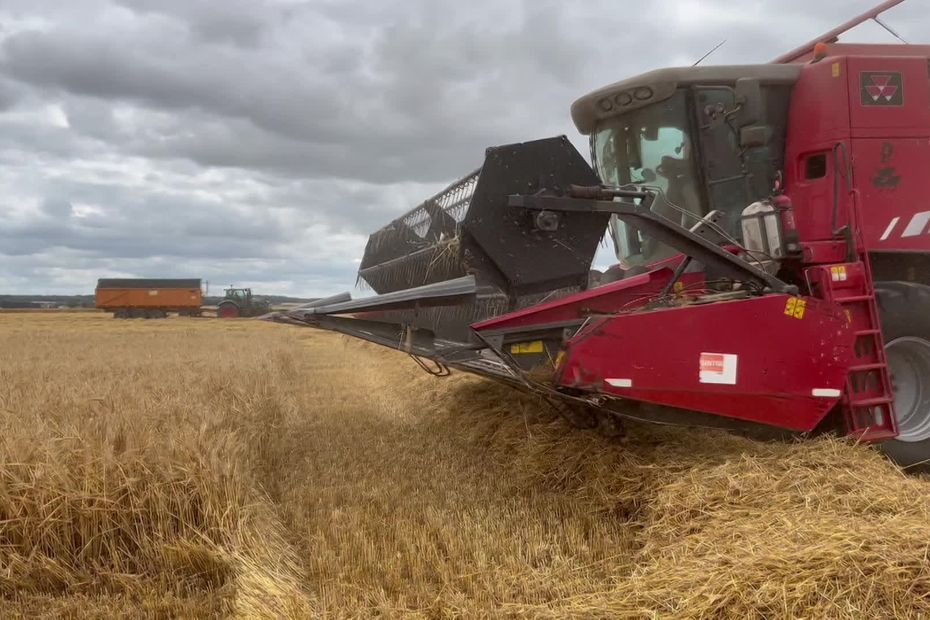At the very beginning of July, the barley harvest is coming to an end and the wheat harvest will begin shortly in the plain of Caen. The weather in recent months has upset the calendar of farmers who are worried about both the quality of their crops and their selling prices in a context marked by the war in Ukraine.
This Sunday, July 2, the clouds are gathering in the sky above the plain of Caen. In Soignolles, combine harvesters have started a race against time and time. The rain would spoil the ongoing winter barley harvest. It would be too stupid a few hours from the end. And yet, the harvest this year is seriously ahead of the usual calendar. “About ten days in advance“, explains Julien Aubré, cereal farmer at the wheel of his imposing vehicle.
A few kilometers to the north, in Fierville-Bray, Geoffroy De Lesquen, vice president of the FDSEA, is preparing to take his combine harvester out of the garage. Usually, he starts harvesting his wheat around July 10-14. “When I look at the ear, the grains of wheat, I can clearly see that they are formed, that they are hard. For me, it’s a plot that will be harvested tomorrow or the day after.“That’s a week ahead of the usual schedule.”It hadn’t happened for a long time. It’s quite surprising.“
When it comes to explaining this early maturity of his wheat, Geoffroy De Lesquen does not have the shadow of a hesitation. “We first had a very dry month of April and beginning of May. We haven’t had a drop of water here, south of Caen. From a vegetative point of view, crops have accelerated things. Then, we had a very very hot period in June. Again, that sped things up.“
A priori, the farmer estimates that he will have finished his harvest at the end of July. In the previous two years, the harvesters had been put to rest in mid-August. “It’s very random from year to year.“, first indicates Geoffroy De Lesquen before agreeing that “compared to ten years ago, the harvest is generally starting earlier. We still have a tendency to mature much faster, we must be clear. We see the impact of climate change.”
In Soignolles, his colleague Julien Aubré confirms and considers the trend even deeper. “Me, I have childhood memories, I finished the harvests at the end of August at the beginning of September”, says the grain farmer“Today it is quite common to finish the first week of August. Compared to 20 years ago, we are well ahead of three weeks“. And this upheaval of the calendar is far from delighting the farmer. “It’s worrying for years to come.” says Julien Aubré“The more the years pass, the more we realize that we are losing in yield and product quality.“.
Early harvests have never been good news for farmers. ” When we have plots that reach maturity very early, it is often a sign of poor yield because these are plots that have suffered“, explains Geoffroy De Lesquen. However, the first observations in his plot of wheat do not plunge him, for the moment, into deep despair.”If I look at the ears, I see that there is grain at the bottom and especially at the top. This means that overall, the ears are well filled. If I look at the size of the grains at a glance, they are pretty good.“There is no question of claiming victory right away. As a good Norman, the “maybe yes, maybe no” is essential. At the national level, the actors of the sector announce a correct soft wheat harvest this year. The yield “would reach 69.5 quintals per hectare in 2022, i.e. -3% compared to the average of the last ten years. The average protein content is estimated at 11.6%, a value corresponding to the ten-year average“, estimates Arvalis (plant institute) in a press release published this week.
Even before starting the harvest, Geoffroy De Lesquen has already sold nearly 40% of his 2022 harvest for several months. The remaining 60% could prove fruitful, if the yield is there. “Last year, we were around 200 euros per tonne. We went up to 400 a few weeks ago. Here we are rather around 300-350“, indicates the farmer. However, serenity is not in order. “Even if the trend is good, there is no guarantee that it won’t go down again in 6 months (…) The big factor is the war in Ukraine. If tomorrow the war stops, they can start exporting massively again and there inevitably the prices will fall.”
Now, if the farmer can store his wheat”at least a year“and sell it when he wants (depending on the price), it is now that he prepares the crops for the following year. “I am buying fertilizer for my 2023 harvest. Prices have increased fourfold. Today, the price of the cereals that I am going to sell is correct and will enable me to buy very, very expensive fertilizers. But in six months, I’m not at all sure. There can be a scissors effect: I can find myself selling my production with prices that will have fallen a lot by having bought extremely expensive fertilizers“, dreads Geoffroy De Lesquen. The farmer has therefore already started looking for buyers for his wheat next year.
–


